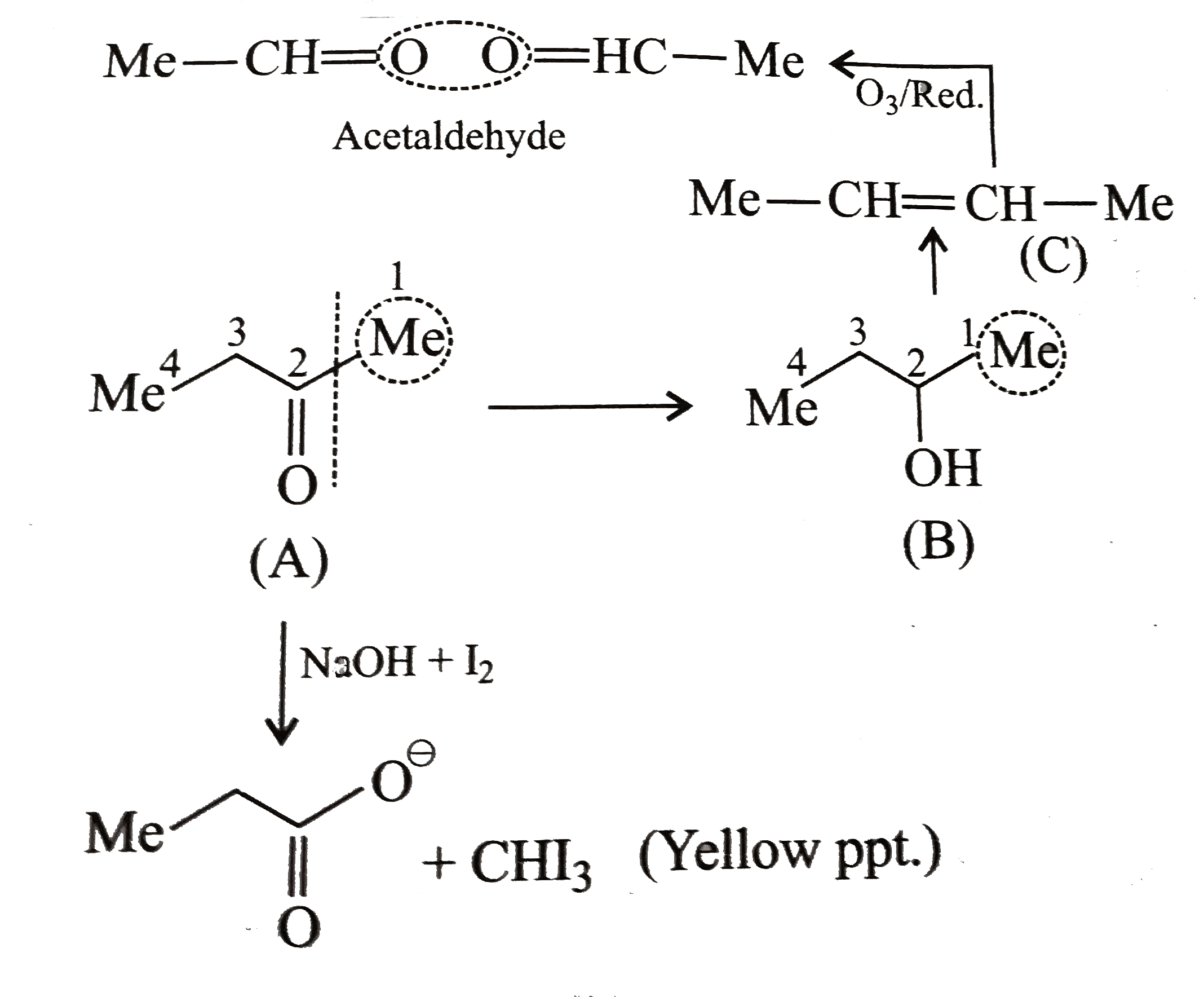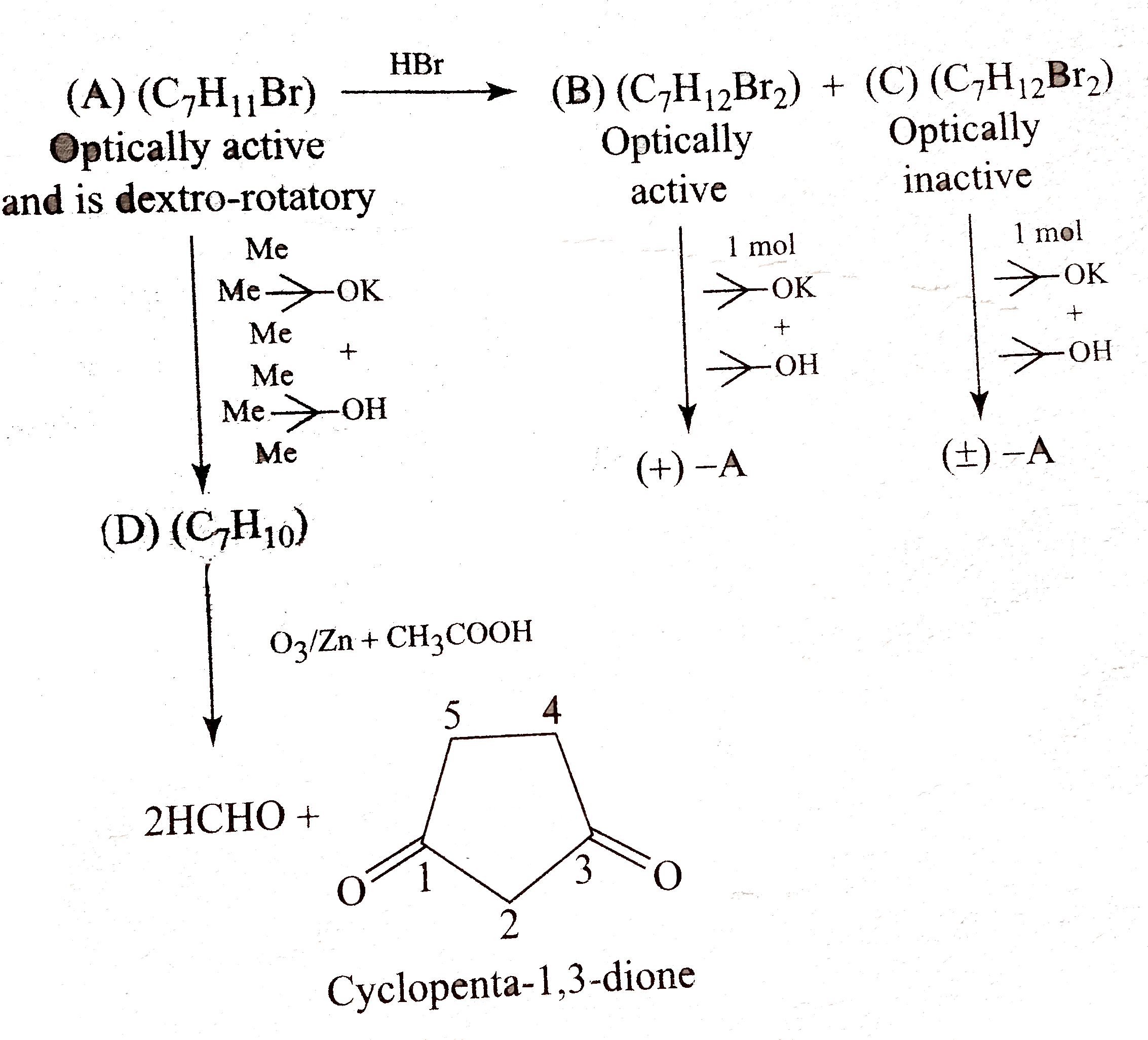A ketone [A] which undergoes haloform reactions gives compound [B] on reduction. [B] on heating with sulphuric acid gives compound [C] which forms monozonide [D}. On hydrolysis in the presence on zinc dust gives acetaldehyde. Identify [A], [B] , [C] and [D]. Write the down the reactions. Involved.
Ketone (A) gives haloform reaction, so it must contain (Me−CO−) group. Ketone on reduction gives 2∘ alcohol. (B), which gives alkene (C) with H2SO4. Alkene on ozonolysis followed by reduction with Zn dust gives MeCHO. So, the structure of alkene (C) is:

So (A) is: Butan-2-one, (B) is: Butan-2-ol, (C) is: Butan-2-one.
Topper's Solved these Questions
- REDUCTION AND OXIDATION REACTION OF ORGANIC COMPOUNDSBOOK - CENGAGE CHEMISTRY ENGLISHCHAPTER - REDUCTION AND OXIDATION REACTION OF ORGANIC COMPOUNDSEXERCISE - SUBJECTIVE TYPE
4 Videos
- REDUCTION AND OXIDATION REACTION OF ORGANIC COMPOUNDSBOOK - CENGAGE CHEMISTRY ENGLISHCHAPTER - REDUCTION AND OXIDATION REACTION OF ORGANIC COMPOUNDSEXERCISE - Exercise (Assertion And Reasoning)
10 Videos
- QUALITATIVE INORGANIC SALT ANALYSISBOOK - CENGAGE CHEMISTRY ENGLISHCHAPTER - QUALITATIVE INORGANIC SALT ANALYSISEXERCISE - Viva Voce Questions And Part-C (Analysis Of Cations)
42 Videos
- SOLID STATEBOOK - CENGAGE CHEMISTRY ENGLISHCHAPTER - SOLID STATEEXERCISE - Ex 1.2 (Objective)
9 Videos
Similar Questions
A ketone A, which undergoes halform reaction, gives compound B on reduction B on heating with sulphuric acid gives compounds C, which forms mono-ozonide D.D on hydrolysis in the presence of zinc dust gives only acetaldehyde. Identify A, B and C. Write down the reaction involved.
View SolutionIdentify [A][B] and [C] and gives the complete chemical reactions involved.

View SolutionA ketone A (C4H8O) which undergoes lodoform reaction gives compound Bon reduction. B on heating with conc. H2SO4 at 443 K gives a compound C which forms ozonide D. Don hydrolysis with Zn dust gives only E. Identify the compounds A to E. Write the lodoform reaction with compound A.
View SolutionAn element A reacts with water to form a compound B which is used in white washing. The compound B on heating forms an oxide C which on treatment with water gives back B. Identify A, B and C and give the reactions involved.
View SolutionAn organic compound A with molecular formula C2H7N on reaction with nitrous acid gives a compound B.B on controlled oxidation gives a compound C. C reduces Tollens' reagent to give silver mirror and D. B reacts with D in the presence of concentrated sulfuric acid to give a sweet smelling compound E. Identify A, B, C, D and E. Give the reaction of C with ammonia and name the product.
View SolutionAn alkali metal A gives a compound B (molecular mass = 40) on reacting with water. The compound B gives a soluble compound C on treatment with aluminium oxide. Identify A, B and C and give the reactions involved.
View SolutionGive the stereochemical forculae for (A),(B)(C), and (D) and also give the reactions involved.

View SolutionAn element A burns with golden flame in air. It reacts with another element B, atomic number 17 to give a product C. An aqueous solution of product C on electrolysis gives a compound D and liberates hydrogen. Identify A, B, C and D. Also write down the equations for the reactions involved.
View SolutionAn organic compound A (C2H6O) reacts with sodium to form a compound B with the evolution of H2 and gives a yellow compound C on reacting with iodine and NaOH. When heated with conc. H2SO4 at 413 K, it gives a compound D (C4H10O) which on reaction wiht conc. HI at 373 K gives compound E. The compound D is also obtained when B is heated with E. Idntify the compounds A,B,C,D and E write the equations for the reaction involved.
View SolutionAn organic compound [A], whose molecular formula is C3H6O, gives iodoform reaction and forms compound [B]. Compound [B], when heated with silver powder, converts into compound [C}. Compound [C] reacts with dil. Sulphuric acid and mercuric sulphate to obtain compound [D], which gives Aldol condensation reaction. Write down the names of all compounds from [A] to [D] and also write the chemical equations for each step.
View Solution
